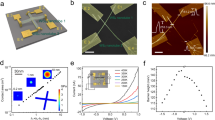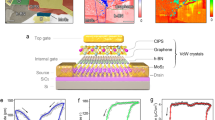Abstract
New non-volatile memories are being investigated to keep up with the organic-electronics road map1. Ferroelectric polarization is an attractive physical property as the mechanism for non-volatile switching, because the two polarizations can be used as two binary levels2. However, in ferroelectric capacitors the read-out of the polarization charge is destructive3. The functionality of the targeted memory should be based on resistive switching. In inorganic ferroelectrics conductivity and ferroelectricity cannot be tuned independently. The challenge is to develop a storage medium in which the favourable properties of ferroelectrics such as bistability and non-volatility can be combined with the beneficial properties provided by semiconductors such as conductivity and rectification. Here we present an integrated solution by blending semiconducting and ferroelectric polymers into phase-separated networks. The polarization field of the ferroelectric modulates the injection barrier at the semiconductor–metal contact. The combination of ferroelectric bistability with (semi)conductivity and rectification allows for solution-processed non-volatile memory arrays with a simple cross-bar architecture that can be read out non-destructively. The concept of an electrically tunable injection barrier as presented here is general and can be applied to other electronic devices such as light-emitting diodes with an integrated on/off switch.
This is a preview of subscription content, access via your institution
Access options
Subscribe to this journal
Receive 12 print issues and online access
$259.00 per year
only $21.58 per issue
Buy this article
- Purchase on Springer Link
- Instant access to full article PDF
Prices may be subject to local taxes which are calculated during checkout




Similar content being viewed by others
References
Scott, J. C. & Bozano, L. D. Nonvolatile memory elements based on organic materials. Adv. Mater. 19, 1451–1463 (2007).
Scott, J. F. & Paz de Araujo, C. A. Ferroelectric memories. Science 246, 1400–1405 (1989).
Scott, J. F. Ferroelectric Memories (Springer, Heidelberg, 2000).
Dawber, M., Rabe, K. M. & Scott, J. F. Physics of thin-film ferroelectric oxides. Rev. Mod. Phys 77, 1083–1130 (2005).
Blom, P. W. M., Wolf, R. M., Cillessen, J. F. M. & Krijn, M. P. C. M. Ferroelectric Schottky diode. Phys. Rev. Lett. 73, 2107–2110 (1994).
Halls, J. J. M. et al. Efficient photodiodes from interpenetrating polymer networks. Nature 376, 498–500 (1995).
Yu, G., Gao, J., Hummelen, J. C., Wudl, F. & Heeger, A. J. Polymer photovoltaic cells: Enhanced efficiencies via a network of internal donor–acceptor heterojunctions. Science 270, 1789–1791 (1995).
Pei, Q., Yu, G., Zhang, C., Yang, Y. & Heeger, A. J. Polymer light-emitting electrochemical cells. Science 269, 1086–1088 (1995).
Meijer, E. J. et al. Solution-processed ambipolar organic field-effect transistors and inverters. Nature Mater. 2, 678–682 (2003).
Chua, L. L. et al. General observation of n-type field-effect behaviour in organic semiconductors. Nature 434, 194–199 (2005).
Kodama, H., Takahashi, Y. & Furukawa, T. Effects of annealing on the structure and switching characteristics of VDF/TrFE copolymers. Ferroelectrics 203, 433–455 (1997).
Van Duren, J. K. J. et al. Injection-limited current in a methanofullerene. J. Appl. Phys. 94, 4477–4479 (2003).
Lovinger, A. J. Ferroelectric polymers. Science 220, 1115–1121 (1983).
Takahashi, T., Date, M. & Fukada, E. Dielectric hysteresis and rotation of dipoles in polyvinylidene fluoride. Appl. Phys. Lett. 37, 791–793 (1980).
Scott, J. C. Is there an immortal memory? Science 304, 62–63 (2004).
Asadi, K., Blom, P. W. M. & de Boer, B. Patent Appl. Nr. EP 07108645.8-2203 (2007).
Naber, R. C. G. et al. High performance solution-processed polymer ferroelectric field effect transistors. Nature Mater. 4, 243–248 (2005).
Acknowledgements
The authors acknowledge the contributions of R. C. G. Naber and D. M. Jarzab to this work, J. Harkema for technical assistance, R. Coehoorn and E. Meulenkamp for stimulating discussions and both the Zernike Institute for Advanced Materials and the EC project PolyApply IST-IP-507143 for financial support.
Author information
Authors and Affiliations
Corresponding author
Supplementary information
Rights and permissions
About this article
Cite this article
Asadi, K., de Leeuw, D., de Boer, B. et al. Organic non-volatile memories from ferroelectric phase-separated blends. Nature Mater 7, 547–550 (2008). https://doi.org/10.1038/nmat2207
Received:
Accepted:
Published:
Issue Date:
DOI: https://doi.org/10.1038/nmat2207
This article is cited by
-
Monolithic In2Se3–In2O3 heterojunction for multibit non-volatile memory and logic operations using optoelectronic inputs
npj 2D Materials and Applications (2022)
-
Advances in flexible organic field-effect transistors and their applications for flexible electronics
npj Flexible Electronics (2022)
-
Molecular ferroelectric/semiconductor interfacial memristors for artificial synapses
npj Flexible Electronics (2022)
-
Vertically stacked, low-voltage organic ternary logic circuits including nonvolatile floating-gate memory transistors
Nature Communications (2022)
-
The Effect of Substrate on the Properties of Non-volatile Ferroelectric P(VDF-TrFE)/P3HT Memory Devices
Chinese Journal of Polymer Science (2022)



